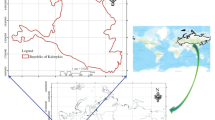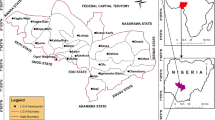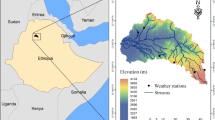Abstract
The exploration of new locations for possible groundwater potentiality is required to support the needs of urban and agricultural activities in arid regions such as Wadi Watir basin. The aim of this study is to locate new groundwater wells that can help overcome the water shortage. In order to define favorable zones for groundwater potentiality, several essential factors contributing to groundwater potentiality were identified. These factors include textural classification of alluvial deposits, lithological units, surface and subsurface structures, topographic parameters, geomorphological features and land use/land cover. A hydrogeological prospective model was developed using spatial data which represent these factors. For final groundwater potential map, all factors were converted to raster data to integrate spatially as important thematic layers based on weightage analysis. The groundwater potential map was classified to five classes including very poor to very good potential. The classes of groundwater potential map were checked against the distribution of the groundwater wells, Bedouin communities and agriculture areas, which present a general knowledge of groundwater potential in the study area.














Similar content being viewed by others
References
Abbas AM, Atya MA, Al-Sayed EA, Kamei H (2004) Assessment of groundwater resources of the Nuweiba area at Sinai Peninsula, Egypt by using geoelectric data corrected for the influence of near surface inhomogeneities. J Appl Geophys 56(2):107–122. doi:10.1016/j.jappgeo.2004.04.002
Abdel-Rahman K, Al-Amri AM, Abdel-Moneim E (2009) Seismicity of Sinai Peninsula, Egypt. Arab J Geosci 2(2):103–118. doi:10.1007/s12517-008-0014-0
Aller L, Bennett T, Lehr JH, Petty RJ (1985) DRASTIC: a standard system for evaluating groundwater pollution potential using hydrogeological settings. EPA/600/2–85/018, R.S. Kerr Environmental Research Laboratory, U.S. Environmental Protection Agency, Ada, Oklahoma
Baharuddin TM, Tjahjanto D, Othman AR, Ab. Latiff, AA, Masiri, K, Wong, WC (2006) Application of geographic information system (GIS) in demarcation groundwater potential zones, National Conference—Water for Sustainable Development Towards a Developed Nation by 2020, 13–14 July 2006, Guoman Resort Port Dickson
Chowdhury A, Jha MK, Chowdary VM (2010) Delineation of groundwater recharge zones and identification of artificial recharge sites in West Medinipur district, West Bengal, using RS, GIS and MCDM techniques. Environ Earth Sci 59(6):1209–1222. doi:10.1007/s12665-009-0110-9
Congalton RG (1991) A review of assessing the accuracy of classifications of remotely sensed data. Remote Sens Environ 37(1):35–46. doi:10.1016/0034-4257(91)90048-B
Conoco (1982) Getchell mine pit water volumes. Inter-office Communication from J.T. McDonough
Edet A, Okereke S, Teme C, Esu O (1998) Application of remote sensing data to groundwater exploration: a case study of the Cross River State, southeastern Nigeria. Hydrogeol J 6(3):394–404. doi:10.1007/s100400050162
Eissa MA, Thomas JM, Pohll G, Hershey RL, Dahab KA, Dawoud MI, Gomaa MA (2013) Groundwater resource sustainability in Wadi Watir delta, Gulf of Aqaba, Sinai, Egypt. Hydrogeol J 21(8):1833–1851. doi:10.1007/s10040-013-1031-y
El Naqa A, Hammouri N, Ibrahim K, El-Taj M (2009) Integrated approach for groundwater exploration in Wadi Araba using remote sensing and GIS. Jord J Civil Eng 3(3):229–243
El-Sammany MS (2010) Forecasting of flash floods over Wadi Watier–Sinai Peninsula using the weather research and forecasting (WRF) model. World Acad Sci Eng Technol 46:996–1000
Elwa HH, El Qaddah AA (2011) Groundwater potentiality mapping in the Sinai Peninsula, Egypt, using remote sensing and GIS-watershed-based modeling. Hydrogeol J 19:613–628
Freund R, Garfunkel Z, Zak I, Goldberg M, Weissbrod T, Derin B (1970) The shear along the Dead Sea Rift. Phil Trans R Soc London A Math Phys Eng Sci 267(1181):107–130. doi:10.1098/rsta.1970.0027
Gaber A, Koch M, El. Baz F (2009) Textural and compositional characterization of Wadi Feiran deposits, Sinai Peninsula, Egypt, using Radarsat-1, PALSAR, SRTM and ETM+ data. Remote Sens J 2(1):52–75
Gaber A, Koch M, Griesh MH, Sato M (2011) SAR remote sensing of buried faults: implications for groundwater exploration in the Western Desert of Egypt. Sens Imaging Int J 12(3–4):133–151. doi:10.1007/s11220-011-0066-1
Ganapuram S, Kumar GT, Krishna IV, Kahya E, Demirel MC (2009) Mapping of groundwater potential zones in the Musi basin using remote sensing data and GIS. Adv Eng Softw 40(7):506–518. doi:10.1016/j.advengsoft.2008.10.001
Garfunkel Z (1981) Internal structure of the Dead Sea leaky transform (rift) in relation to plate kinematics. Tectonophysics 80:81–108. doi:10.1016/0040-1951(81)90143-8
Hassan OA, Ahmed MH, Arafat SM (2005) Environmental land use/landcover use change detection in coastal zones of the Gulf of Aqaba, Egypt, using multi-temporal Landsat imagery. Egypt J Remote Sens Space Sci 8:21–38
Horton RE (1945) Erosional development of streams and their drainage basins: hydrophysical approach to quantitative morphology. Geol Soc Am Bull 56(3):275–370. doi:10.1130/0016-7606(1945)56[275:EDOSAT]2.0.CO;2
Houhoulis PF, Michener WK (2000) Detecting wetland change: a rule-based approach using NWI and SPOT-XS data. Photogramm Eng Remote Sens 66(2):205–211
Jensen JR (2000) Active and passive microwave, and LIDAR remote sensing. Remote sensing of the environment: an earth resource perspective. Prentice-Hall, NJ , pp. 285–332Chap 9
Kaiser MF (2013) GIS data integration for SRTM-Landsat ETM+–Radarsat-1 images to delineate subsurface paleolakes, Wadi Watir area, Egypt. Proceedings of the international geo-science and remote sensing symposium, Jul 2013, 3594–3597
Khalid AM (1993) Geology and geochemistry of Nuweiba area, South Sinai, Egypt. Ph.D. Dissertation, Geology Department, Suez Canal University, Ismailia, Egypt
Khalil MH (2010) Hydro-geophysical configuration for the quaternary aquifer of Nuweiba alluvial fan. J Environ Eng Geophys 15(2):77–90. doi:10.2113/JEEG15.2.77
Krishnamurthy J, Mani A, Jayaraman V, Manivel M (2000) Groundwater resources development in hard rock terrain-an approach using remote sensing and GIS techniques. Int J Appl Earth Obs Geoinf 2(3):204–215. doi:10.1016/S0303-2434(00)85015-1
Lyberis N (1988) Tectonic evolution of the Gulf of Suez and the Gulf of Aqaba. Tectonophysics 153(1):209–220. doi:10.1016/0040-1951(88)90016-9
Madrucci V, Taioli F, de Araújo CC (2008) Groundwater favorability map using GIS multicriteria data analysis on crystalline terrain, Sao Paulo state, Brazil. J Hydrol 357(3):153–173. doi:10.1016/j.jhydrol.2008.03.026
Magesh NS, Chandrasekar N, Soundranayagam JP (2012) Delineation of groundwater potential zones in Theni district, Tamil Nadu, using remote sensing, GIS and MIF techniques. Geosci Front 3(2):189–196. doi:10.1016/j.gsf.2011.10.007
Masoud AA (2009) Runoff modeling of the Wadi systems for estimating flash flood and groundwater recharge potential in southern Sinai Egypt. Arab J Geosci 4(5–6):785–801. doi:10.1007/s12517-009-0090-9
Mohamaden MI (2005) Electric resistivity investigation at Nuweiba Harbor Gulf of Aqaba, South Sinai, Egypt. Egypt J Aquat Res 31:57–68
Muralidhar M, Raju KRK, Raju KSVP, Prasad JR (2000) Remote sensing applications for the evaluation of water resources in rainfed area, Warangal district, Andhra Pradesh. Indian Mineral 34:33–40
Obiefuna GI, Sheriff A (2011) Assessment of shallow ground water quality of Pindiga Gombe area, Yola area, NE, Nigeria for irrigation and domestic purposes. J Environ Earth Sci 3(2):131–141
Robinson C, El-Baz F, Singhory V (1999) Subsurface imaging by RADARSAT: comparison with Landsat TM data and implications for groundwater in the Selima area, northwestern Sudan. Can J Remote Sens 25(3):268–277. doi:10.1080/07038992.1999.10874725
Said R (1962) The geology of Egypt . Elsevier, Amsterdam-New York377 pp
Sander P, Chesley MM, Minor TB (1996) Groundwater assessment using remote sensing and GIS in a rural groundwater project in Ghana: lessons learned. Hydrogeol J 4(3):40–49. doi:10.1007/s100400050086
Saraf AK, Choudhury PR (1998) Integrated remote sensing and GIS for groundwater exploration and identification of artificial recharge sites. Int J Remote Sens 19(10):1825–1841. doi:10.1080/014311698215018
Saraf AK (1999) IRS-1C-LISS-III and PAN data fusion: an approach to improve remote sensing based mapping techniques. Int J Remote Sens 20(10):1929–1934. doi:10.1080/014311699212272
Sener A, Davraz A, Ozcelik M (2005) An integration of GIS and remote sensing in groundwater investigations: a case study in Burdur, Turkey. Hydrogeol J 13(5–6):826–834. doi:10.1007/s10040-004-0378-5
Sherief Y (2008) Flash floods and their effects on the development in El Qaa Plain area in south Sinai, Egypt—a study in applied geomorphology using GIS and remote sensing. Ph.D. Dissertation, Johannes Gutenberg-Universität Mainz
Solomon S, Quiel F (2006) Groundwater study using remote sensing and geographic information systems (GIS) in the central highlands of Eritrea. Hydrogeol J 14(6):1029–1041. doi:10.1007/s10040-006-0096-2
Solomon S (2003) Groundwater study using remote sensing and geographic information systems (GIS) in the central highlands of Eritrea. Ph.D. Dissertation, Department of Environmental and Natural Resources Information Systems, Royal Institute of Technology, Stockholm, Sweden
Srivastava PK, Bhattacharya AK (2006) Groundwater assessment through an integrated approach using remote sensing, GIS and resistivity techniques: a case study from a hard rock terrain. Int J Remote Sens 27(20):4599–4620. doi:10.1080/01431160600554983
Süzen ML, Toprak V (1998) Filtering of satellite images in geological lineament analyses: an application to a fault zone in Central Turkey. Int J Remote Sens 19(6):1101–1114. doi:10.1080/014311698215621
Thomas A, Sharma PK, Sharma MK, Anil S (1999) Hydrogeomorphological mapping in assessing groundwater by using remote sensing data case study in Lehra gage block, Sangrur district, Punjab. J Indian Soc Remote Sens 27:31–42. doi:10.1007/BF02990773
Thornbury WD (1985) Principles of geomorphology. Wiley Eastern Ltd., New Delhi
Tweed SO, Leblanc M, Webb JA, Lubczynski MW (2007) Remote sensing and GIS for mapping groundwater recharge and discharge areas in salinity prone catchments, southeastern Australia. Hydrogeol J 15(1):75–96. doi:10.1007/s10040-006-0129-x
Acknowledgments
The author greatly thanks National Aeronautics and Space Administration (NASA), for providing satellite image. I wish to express sincere gratitude and appreciation to Prof. Dr. Samir Khwasik, Professor of Structural Geology, Faculty of Science, Suez Canal University, Egypt, for his encouragement and recommendations. I thank the Egyptian Ministry of Higher Education and Scientific Research for his financial support.
Author information
Authors and Affiliations
Corresponding author
Rights and permissions
About this article
Cite this article
Abuzied, S.M. Groundwater potential zone assessment in Wadi Watir area, Egypt using radar data and GIS. Arab J Geosci 9, 501 (2016). https://doi.org/10.1007/s12517-016-2519-2
Received:
Accepted:
Published:
DOI: https://doi.org/10.1007/s12517-016-2519-2




